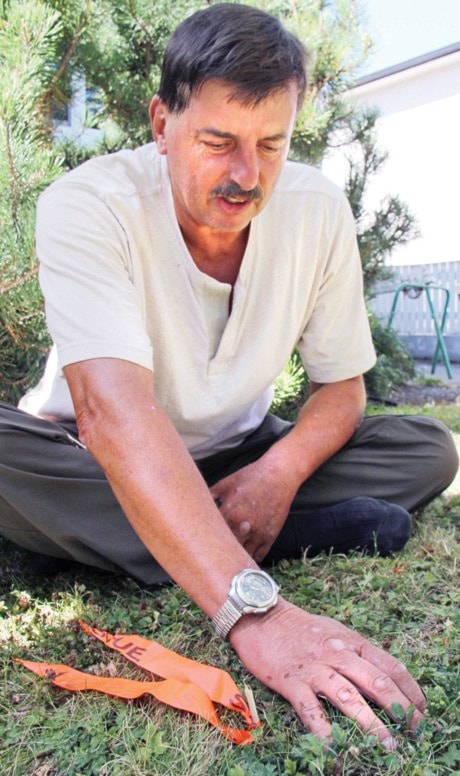Within seconds Ben van Drimmelen’s hand is swarming with European fire ants.
All it took was one solid thump over where he knew there was a nest – an easy process since he pounded his entire front yard earlier and found five nests in a one-metre section.
“The odd behaviour is the strong bite and the swarming action,” the Oak Bay man said, ants crawling across his calloused hand. “They’re nasty, biting, little invasives.”
He’s been trying to get rid of them since discovering the pests living alongside the harmless black ants in his yard in the mid-1990s.
“I didn’t know they were non-native,” he said. “I knew they were annoying.”
This summer, van Drimmelen learned exactly how invasive the pests are after reading media coverage of a European fire ant problem on the Lower Mainland that cited leading B.C. expert Robert Higgins.
Higgins hopes to spread that knowledge given new funding from the province and the growing concern over the tiny, feisty pests.
“One of the many challenges with this new invasive is that few people work with ants and are able to identify them. Right now I am the only person in the province, but a workshop is in the planning stages to train more people,” the entomologist explained. “We’re trying to provide some more information to municipalities so they can stickhandle this.”
A little while later, van Drimmelen simply places his hand on the lawn, with similar swarming affect – no thump necessary. Although only four millimetres long, the ants are known to swarm and sting without provocation, putting the kibosh on bocce, relaxing on the grass and backyard parties, said van Drimmelen’s neighbour Rhea Cavelti.
“Once the kids are bitten, After Bite doesn’t work. … The (welts) get massive,” Cavelti said.
Higgins explained that the European fire ants became a noted pest about 15 years ago.
“(The species is) forming much denser colonies in areas that it’s moving into. And it’s becoming much more aggressive,” he said. “This ant doesn’t behave this way in Europe. It doesn’t form colonies anywhere near as densely as in North America. … They seem to understand they are dominating the area and can afford to be aggressive.”
Along with Greater Victoria, the thin, red ants have been found around Chilliwack, North Vancouver and Burnaby.
“It is to the best of our knowledge localized right now to perhaps half a dozen residences (in Greater Victoria),” Higgins said. “The province has approved funding to map their distribution in more detail. … By the end of summer we hope to have a better idea of where it is, at least where it’s established.”
A retired biologist, van Drimmelen looks forward to Higgins’ mapping the species and discovering a safe way to combat them. Traditional ant-killing methods have yet to work.
“I’m hoping there’s a way to control these ants without killing the other nice ants,” van Dimmelen said. So far Higgins finds boric acid at a very specific concentration does the trick and is guiding residents accordingly.
“We’re going to be setting up a process, so we can provide some information to municipalities if they become the first contact for these issues,” Higgins said.
They hope to have students mapping and trapping in the neighbourhood this week.
Learn more about the species, or contact Higgins through Thompson Rivers University at www.tru.ca/faculty/rhiggins.
Rising temper with temperature
The European fire ant is not a morning creature. In the cold and damp it’s sluggish but as the temperature heats up, say to 20 degrees, it begins to move faster.
“It only tends to sting when you get it under clothing and press against it,” said entomologist Rob Higgins. When the weather hits 25 degrees, this invasive fire ant will “sting without the necessity of clothing,” he added. “They show the worst behaviour on warm humid muggy evenings.”
Stop the spread
A queen is required to establish new colonies, so simply walking isn’t a danger to spreading the species. Those who have a dreaded ant colony shouldn’t transport soil.
“It’s important not to remove soil from the area, because we don’t want to spread ants from the area,” Higgins said. If you’re digging up plants and sending them to a friend or a neighbour, immerse the roots in water for an hour to kill any potential of transporting a queen. “We definitely want to contain this. … It’s going to be a fight to knock it back.”
